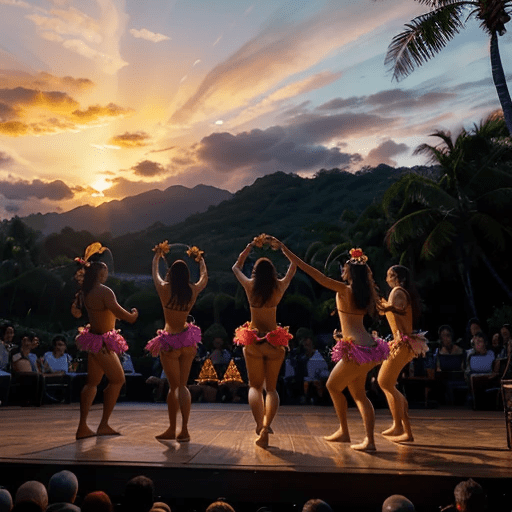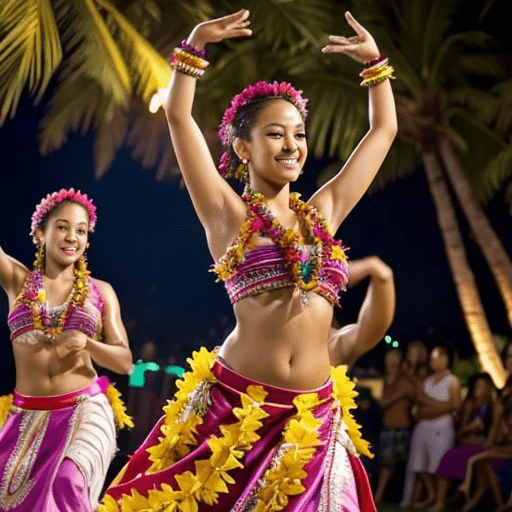Have you ever wondered about the diverse birds of Oahu? This island, renowned for its stunning beaches and vibrant culture, is also a haven for bird enthusiasts.
Let’s embark on a journey to explore the avian wonders of this Hawaiian paradise.
Birds of Oahu: Why Oahu Is A Birdwatcher’s Dream
Oahu, often referred to as “The Gathering Place,” is not just a melting pot of cultures but also a confluence of diverse ecosystems.
This Hawaiian island, nestled in the heart of the Pacific, boasts a rich tapestry of habitats ranging from lush rainforests and misty mountains to arid plains and coastal wetlands.
Each of these habitats plays host to a distinct set of avian species, making Oahu a veritable treasure trove for bird enthusiasts.
An excellent place to start is with the island’s native birds. Isolated from the rest of the world, these species have evolved unique adaptations to thrive in Oahu’s specific conditions.
The sight of a Hawaiian Honeycreeper flitting about, with its vibrant plumage and specialized beak, is enough to make any birdwatcher’s heart flutter.
But Oahu’s avian allure doesn’t end with its native species. Over the years, birds from different parts of the world have found their way to this island, either accidentally or introduced by humans.
These introduced species, like the melodious White-rumped Shama or the striking Red-crested Cardinal, add layers of complexity to Oahu’s birdwatching scene.
While some purists might argue in favor of native species, there’s no denying the charm that these newcomers bring to the table.
Furthermore, Oahu’s accessibility makes it a dream destination for birdwatchers. Whether you’re strolling through the bustling streets of Honolulu or hiking up the verdant trails of the Ko’olau Range, you’re never too far from a birdwatching opportunity.
Add to this the island’s pleasant tropical climate, and you have the perfect recipe for hours of uninterrupted birdwatching.
In essence, Oahu offers a symphony of sights and sounds that beckon birdwatchers from all walks of life.
Whether you’re an amateur hoping to catch a glimpse of your first Hawaiian bird or a seasoned ornithologist looking to add to your life list, Oahu promises an experience that’s both enriching and exhilarating.

The Unique Birds Of Oahu
Oahu, a gem in the Hawaiian archipelago, is not just renowned for its sun-kissed beaches and azure waters but also for its eclectic mix of avian wonders.
The island’s unique geographical location, coupled with its varied ecosystems, has given rise to a bird population that’s as diverse as it is captivating.
The Zebra Dove, with its soft, melodious coos, is a familiar sound to anyone wandering the streets of Oahu.
These petite birds, with their characteristic black and white striped necks, can often be seen foraging on the ground, unfazed by the hustle and bustle around them. Their gentle demeanor and harmonious chirps add a touch of serenity to Oahu’s urban landscapes.
On the other hand, the Red-crested Cardinal is impossible to overlook. With its brilliant red head and chest contrasting against a sleek white belly and dark wings, it’s a splash of color in Oahu’s greenery.
Native to South America, this bird has found a new home in Hawaii and is often spotted in open areas, parks, and gardens, adding vibrancy wherever it goes.
But Oahu’s avian tapestry doesn’t stop here. The island is home to several endemic species, birds that are found nowhere else on Earth.
The Hawaiian Honeycreepers, for instance, are a group of birds that have evolved in isolation on these islands. With their varied beak shapes and sizes, each adapted to a specific type of food source, they are a living testament to nature’s creativity.
Plan Your Hawaiian Adventure Today
Camper Vans | Surf Boards | Kayaks | Snorkel Gear | Itineraries | Campsites | More…
Then there’s the Pacific Golden Plover, a migratory marvel that travels thousands of miles from Alaska to winter in the warm climes of Oahu.
Watching these birds, with their distinctive gold-speckled plumage, forage on Oahu’s shores is a sight to behold.
And let’s not forget the nocturnal wonders like the Hawaiian Owl or Pueo, a guardian spirit in Hawaiian culture.
Spotting one of these majestic birds during a twilight drive or hike is considered a blessing by many locals.
Oahu’s birds are more than just creatures with feathers. They are storytellers, each with a unique tale of evolution, adaptation, and survival.
They are a bridge between the island’s ancient past and its present, between its indigenous culture and its global influences.
For anyone willing to listen, watch, and wonder, the birds of Oahu offer a sensory feast that’s unparalleled.

Birds of Oahu: Native Species And Their Significance
Oahu’s native birds are a vibrant representation of the island’s unique biodiversity. These species, having thrived in Oahu’s diverse habitats for countless generations, embody the essence of the island’s natural beauty and ecological richness.
Each native bird species carries with it a legacy of survival and adaptation. The Hawaiian Honeycreepers, for instance, have developed distinct feeding habits and behaviors that allow them to flourish in specific niches within the island’s ecosystems. Their varied beak shapes and sizes are tailored to different food sources, from nectar to seeds, showcasing nature’s intricate design.
Beyond their ecological roles, these native species hold profound cultural and spiritual significance for the native Hawaiians.
Birds like the Iiwi, with its radiant scarlet plumage, and the Pueo (Hawaiian Owl) are deeply woven into Hawaiian folklore, chants, and rituals.
They symbolize the deep connection between the land, its people, and the cosmos.
Birds of Oahu: Introduced Species And Their Impact
The tapestry of Oahu’s birdlife is further enriched by the presence of introduced species. Birds like the Red-crested Cardinal or the Java Sparrow bring with them a touch of the exotic, adding new colors and sounds to the island’s avian chorus.
However, these introduced species, being newcomers to the island’s ecosystems, can sometimes disrupt the delicate balance.
Without the checks and balances they faced in their original habitats, these birds can proliferate rapidly, often competing with native species for resources.
For example, the Common Myna, with its striking appearance and bold behavior, can sometimes dominate food sources and nesting sites, pushing native species to the margins.
Recognizing the influence of these introduced species is vital for conservation. It’s about understanding their role in the current ecosystem and devising strategies to ensure that native species continue to thrive.
Conservationists aim to strike a balance, ensuring that both native and introduced species coexist harmoniously, preserving the rich birdlife that makes Oahu so special.
In essence, Oahu’s birdlife, with its mix of native and introduced species, paints a picture of nature’s resilience and adaptability.
It’s a reminder of the need to respect and protect the natural world, ensuring that future generations can also revel in the island’s avian wonders.

Top 5 Must-See Birds Of Oahu
Oahu’s skies and forests are adorned with a plethora of bird species, each with its own unique charm and story.
For those who have a penchant for avian wonders, here’s a deeper dive into the top five birds that every nature enthusiast should keep an eye out for:
Pacific Golden Plover: A migratory marvel.
The Pacific Golden Plover, known locally as the Kōlea, is a true testament to the wonders of long-distance migration. These elegant birds travel thousands of miles from the Arctic to the warm shores of Oahu, making this incredible journey twice a year. With their distinctive gold-speckled plumage, they grace the island’s beaches and grasslands, foraging for insects and crustaceans. Their presence signals the changing of seasons and is a sight that resonates with both locals and visitors.
White-rumped Shama: Melodious and mesmerizing.
The White-rumped Shama is a songbird that captures the heart with its enchanting melodies. With a long, flowing tail and a combination of orange, black, and white plumage, its beauty is undeniable. But it’s the bird’s song—a series of varied whistles, clicks, and chirps—that truly sets it apart. Often heard before it’s seen, the Shama’s song is a melodious backdrop in Oahu’s forests.
Red-vented Bulbul: A dash of color.
The Red-vented Bulbul, with its sleek black body, contrasting white underparts, and signature red patch beneath its tail, is a visual delight. These birds are active and curious, often seen flitting about in search of fruits and insects. Their playful nature and striking appearance make them a favorite among birdwatchers and photographers alike.
Plan Your Hawaiian Adventure Today
Camper Vans | Surf Boards | Kayaks | Snorkel Gear | Itineraries | Campsites | More…
Japanese White-eye: Tiny but noticeable.
Don’t let its small size fool you; the Japanese White-eye is a bird that demands attention. With its vibrant green body and distinctive white eye-ring, it’s a splash of color in Oahu’s green canopies. These birds are social and often move in flocks, feeding on nectar, fruits, and insects. Their sweet, warbling calls add a touch of magic to any nature walk.
Common Myna: Ubiquitous and vocal.
The Common Myna is hard to miss. With its brown body, bright yellow eye patches, and legs, it stands out in urban and rural settings alike. Originally from South Asia, these birds have made Oahu their home, adapting seamlessly to the island’s environment. They’re known for their varied calls and ability to mimic sounds. Whether you’re in a park, beach, or your backyard, the Myna’s vocal performances are a regular feature.
Each of these birds, with their unique behaviors, calls, and appearances, offers a different slice of Oahu’s rich avian tapestry.
Whether you’re a seasoned birdwatcher or someone just starting out, these species promise unforgettable encounters with nature’s wonders.

Birdwatching Spots In Oahu
Oahu, often dubbed “The Gathering Place,” is not just a hub for cultural confluence but also a haven for bird enthusiasts.
The island’s diverse landscapes, from its urban centers to its untouched natural reserves, provide a myriad of spots for birdwatching.
Here’s a deeper look into some of the most renowned locales where both novice and seasoned birdwatchers can indulge in their passion:
Kāneʻohe Bay Wetlands:
Located on the windward side of Oahu, the wetlands of Kāneʻohe Bay are a magnet for waterfowl and waders. The marshy grounds and shallow waters provide the perfect habitat for birds like the Pacific Golden Plover and the Hawaiian Stilt. With the majestic Ko’olau Mountains as a backdrop, birdwatching here is as scenic as it is rewarding.
Waimea Valley:
This lush botanical garden in the North Shore region is not just a repository of exotic plants but also a sanctuary for various bird species. The dense foliage and flowing streams attract birds like the Japanese White-eye and the Red-crested Cardinal. The valley’s serene ambiance, punctuated by bird calls, makes it a favorite among nature lovers.
Diamond Head State Monument:
While primarily known for its panoramic views of Honolulu, Diamond Head is also a birdwatching spot. The slopes and cliffs are home to seabirds like the White-tailed Tropicbird. As you ascend the trail, keep an ear out for the melodic tunes of the White-rumped Shama echoing amidst the rocks.
Hoʻomaluhia Botanical Garden:
Nestled in Kāneʻohe, this expansive garden is a tapestry of tropical plants and freshwater lakes. Birds like the Common Myna and Zebra Dove are regulars here. The garden’s tranquility, combined with its diverse avian life, makes it a birdwatcher’s paradise.
James Campbell National Wildlife Refuge:
Situated on the northeastern coast of Oahu, this refuge is dedicated to preserving habitats for Hawaii’s native waterbirds. With its wetlands, ponds, and grasslands, it’s a hotspot for birds like the Hawaiian Coot and the Hawaiian Duck. Seasonal migrations also bring in a variety of shorebirds, making it a must-visit during migration periods.
Downtown Honolulu:
Surprisingly, the urban heart of Oahu is also a birdwatching locale. Parks like the Ala Moana Beach Park and the grounds of the ‘Iolani Palace are frequented by birds like the Red-vented Bulbul and the Spotted Dove. Amidst the city’s hustle and bustle, these birds offer a touch of nature.
It’s important to mention that some of these locations might involve hiking. It’s advisable to do some research beforehand to be prepared.

Birds of Oahu: Urban Areas And Parks
The bustling urban landscapes of Oahu, with their skyscrapers and busy streets, might seem an unlikely place for birdwatching.
However, these areas are teeming with avian life, making them perfect for those who want to indulge in birdwatching without venturing too far.
Parks like Ala Moana Beach Park and Kapiolani Park are green oases amidst the urban sprawl. Here, amidst the shade of banyan trees and the gentle rustle of palm fronds, birds like the House Sparrow and Java Sparrow have made their homes.
These birds have adapted remarkably well to city life, often seen hopping around benches, foraging for crumbs, or chirping merrily from tree branches.
Apart from sparrows, urban areas also play host to birds like the Zebra Dove, Common Myna, and the Red-vented Bulbul.
These birds have become an integral part of the city’s soundscape, their calls blending seamlessly with the hum of traffic and chatter of people.
For those with a tight schedule or those who prefer the convenience of city life, urban areas and parks in Oahu offer a delightful birdwatching experience, proving that you don’t always need to venture into the wild to connect with nature.
Plan Your Hawaiian Adventure Today
Camper Vans | Surf Boards | Kayaks | Snorkel Gear | Itineraries | Campsites | More…
Birds of Oahu: The Best Time To Birdwatch In Oahu
Oahu, with its temperate climate and diverse habitats, is a haven for birds throughout the year. However, like all destinations, there are specific times when the birdwatching experience is elevated, especially if you’re keen on spotting migratory species or witnessing unique avian behaviors.
Spring (March to May):
Spring is a particularly exciting time for birdwatchers in Oahu. As the island bursts into bloom, many migratory birds make their way back from their wintering grounds. The Pacific Golden Plover, for instance, returns from its long journey from Alaska, its golden-speckled plumage a sight to behold. Additionally, many native birds begin their nesting season, making it a great time to observe courtship behaviors and nesting rituals.
Summer (June to August):
The warm summer months see a surge in the activity of resident birds. The lush landscapes and abundant food sources make it an ideal time for breeding. Birds like the White-rumped Shama and Red-crested Cardinal are in full song, serenading potential mates. While migratory activity is lower, the vibrant behaviors of local birds more than make up for it.
Fall (September to November):
As the leaves start to change, so does the avian landscape of Oahu. Fall marks the departure of some migratory species and the arrival of others. Birds like the Wandering Tattler can be seen along the shores, taking a break before continuing their southward journey. The cooler temperatures and changing foliage also offer a different, serene backdrop for birdwatching.
Winter (December to February):
Winter in Oahu is special for bird enthusiasts. The island becomes a refuge for many migratory birds escaping the colder climates of the north. Wetlands and beaches are dotted with species like the Bristle-thighed Curlew and the Ruddy Turnstone. It’s also a great time to spot the majestic Humpback Whales off the coast, adding an extra layer to the wildlife-watching experience.
while Oahu offers a rich birdwatching experience year-round, aligning your visit with specific seasons can enhance the experience. Whether you’re keen on spotting rare migrants, observing breeding behaviors, or simply soaking in the island’s natural beauty, there’s always a perfect time to have your binoculars at the ready in Oahu.

Birds of Oahu: Essential Gear For Birdwatching
Embarking on a birdwatching adventure in Oahu is an exhilarating experience, but having the right gear can make all the difference.
Being well-equipped not only enhances your birdwatching experience but also ensures comfort and safety.
Here’s a deeper dive into the essential gear you should consider packing for your avian adventure:
Binoculars:
A good pair of binoculars is the cornerstone of any birdwatching expedition. Opt for a pair with a magnification of 8×42 or 10×42, which offers a wide field of view and bright images. Waterproof and fog-resistant features can be beneficial, especially in Oahu’s varied climates.
Sturdy Hat:
Oahu’s tropical sun can be intense. A wide-brimmed hat not only provides protection against UV rays but also helps reduce glare, ensuring you get a clear view of your feathered subjects. Additionally, it offers protection against unexpected rain showers.
Reliable Guidebook:
A comprehensive bird guidebook specific to Hawaii or Oahu can be invaluable. It helps in identifying species, understanding their behaviors, and knowing their habitats. Many guidebooks also come with illustrations or photographs, making identification easier and more enjoyable.
Comfortable Footwear:
Given that some of the best birdwatching spots might require a bit of hiking or walking on uneven terrains, investing in a pair of comfortable, sturdy shoes or hiking boots is crucial. Waterproof options can be a bonus for wet or dewy trails.
Notebook and Pen:
Documenting your sightings can be both fun and informative. A compact notebook allows you to jot down details of the birds you spot, their behaviors, and the locations of your sightings. Over time, this can become a cherished record of your birdwatching adventures.
Camera with a Zoom Lens:
If you’re keen on capturing the beauty of the birds you spot, a camera with a good zoom lens is essential. It allows you to take detailed shots from a distance without disturbing the birds.
Plan Your Hawaiian Adventure Today
Camper Vans | Surf Boards | Kayaks | Snorkel Gear | Itineraries | Campsites | More…
Birding Apps:
Modern technology has brought birdwatching to our fingertips. Several apps offer real-time bird identification, calls, and even tracking. They can be a great supplement to traditional guidebooks.
Backpack:
A lightweight, durable backpack is essential to carry all your gear, snacks, water, and any additional clothing layers. Opt for one with multiple compartments for easy organization.
Sunscreen and Bug Repellent:
Protecting yourself from the sun’s rays and keeping pesky insects at bay will make your birdwatching experience more comfortable. Ensure you have a good sunscreen and a reliable insect repellent in your pack.
while the allure of birdwatching lies in the birds themselves, being well-prepared with the right gear ensures that you can focus on the experience without any distractions.
Whether you’re a seasoned birder or a newbie, these essentials will set you up for a memorable outing in Oahu’s avian paradise.

Tips For A Successful Birdwatching Trip
Embarking on a birdwatching journey, especially in a place as diverse as Oahu, can be a thrilling experience. However, to make the most of it, certain guidelines and tips can be invaluable:
Research Before You Go:
Familiarize yourself with the common bird species of the area. Knowing what to expect can help you identify and appreciate the birds better. Websites, local birdwatching groups, and guidebooks can be great resources.
Patience is Key:
Birds are wild creatures, and they won’t always appear on cue. Sometimes, you might have to wait for extended periods to spot a particular species. Embrace the waiting time as a chance to connect with nature and enjoy the serenity.
Understand Behavior and Habitat:
Observing a bird’s behavior can be as rewarding as spotting it. Notice their feeding habits, their interactions with other birds, and their flight patterns. This not only enhances the experience but also provides insights into their lives.
Stay Quiet and Minimize Movement:
Loud noises and sudden movements can scare birds away. When in a birdwatching spot, try to be as inconspicuous as possible to increase your chances of sightings.
Join a Group or Hire a Guide:
Especially if you’re new to birdwatching, joining a group or hiring a local guide can be beneficial. They can provide valuable insights, share experiences, and help you spot elusive species.

The Connection Between Birds and Hawaiian Culture
Birds have always been integral to Hawaiian culture, playing roles in myths, legends, and daily life:
Symbols of Deities:
Many Hawaiian gods and goddesses have bird forms or are associated with specific birds. For instance, the `io (Hawaiian Hawk) is considered a royal bird and is believed to be an ‘aumakua or ancestral spirit.
Navigational Aids:
Ancient Polynesian navigators used the flight patterns of migratory birds as guides to discover new lands, including the Hawaiian Islands.
Featherwork:
Birds provided feathers for the creation of capes, helmets, and other ceremonial items for Hawaiian royalty. These intricate and vibrant pieces showcased the craftsmanship and artistry of ancient Hawaiians.
Songs and Chants:
Birds feature prominently in Hawaiian mele (songs) and oli (chants), symbolizing various emotions, stories, and natural phenomena.
Plan Your Hawaiian Adventure Today
Camper Vans | Surf Boards | Kayaks | Snorkel Gear | Itineraries | Campsites | More…
Conservation Efforts In Oahu
Oahu’s rich avian biodiversity is under threat from habitat loss, invasive species, and climate change. However, conservationists are at the forefront of efforts to protect these feathered inhabitants:
Habitat Restoration:
Efforts are underway to restore native forests and wetlands, providing safe havens for birds to thrive.
Species Recovery Programs:
Endangered birds, like the Hawaiian Stilt, are beneficiaries of breeding and recovery programs aimed at increasing their populations.
Education and Awareness:
Local organizations conduct workshops, birdwatching tours, and educational programs to raise awareness about the importance of birds and the need for their conservation.
Research and Monitoring:
Continuous research helps in understanding bird populations, their behaviors, and the challenges they face, guiding conservation strategies.

How To Respect The Natural Habitat
While Oahu welcomes birdwatchers and nature enthusiasts, it’s crucial to respect its natural habitats:
Stick to Designated Paths:
Straying off the path can harm delicate ecosystems. Always stay on marked trails to minimize your impact.
Avoid Feeding the Birds:
Human food can be harmful to birds and can disrupt their natural feeding habits. Always resist the urge to feed them.
Leave No Trace:
Carry out all trash and belongings. Leaving garbage behind can harm both the environment and its inhabitants.
Maintain a Safe Distance:
While it’s tempting to get close for a better view or a photograph, always maintain a respectful distance to avoid stressing the birds.
Educate Others:
Share the principles of responsible birdwatching with fellow travelers, ensuring that everyone does their part in preserving Oahu’s natural wonders.
By following these guidelines and tips, birdwatchers can ensure that their experience is not only rewarding but also sustainable, contributing to the preservation of Oahu’s avian treasures for future generations.
That about sums it up on the birds of Oahu. For more bird-watching tips, check out our ultimate guide to bird watching !
Birds of Oahu: FAQs
Early morning or late afternoon is ideal.
Yes, several organizations offer guided tours.
Support local NGOs and participate in awareness programs.
It’s best to observe from a distance to avoid disturbing them.
Absolutely! It’s a great way to introduce them to nature.
How do you like the birds of Oahu? Please share your thoughts with us in the comments!






